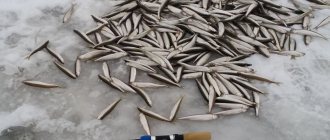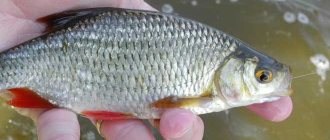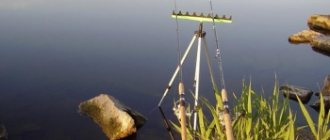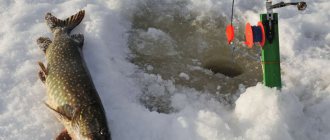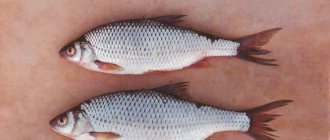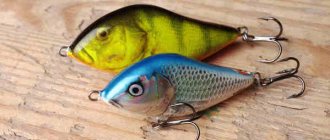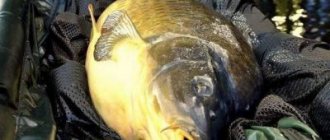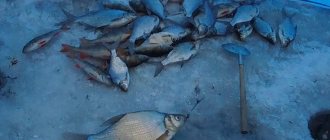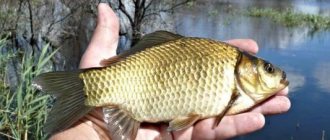Winter fishing at sea, making a tyrant for catching smelt
Making bait for sea ice fishing.
The most catchy gear when fishing for smelt are samolov (aka tyrant) and spoons (when fishing with flywheels). When fishing with these rigs, the catch can be counted not only in tens, hundreds, but in some cases even in thousands of tails (with a good bite), it is measured in buckets from under the “terrac”, a popular measure, so to speak.
In this material we will talk about the tyrant, or rather, we will look at the design of his equipment, learn how to knit a bait and attach it to a fishing line, and in the end we will get a device ready for fishing.
Hooks - I use Japanese ones, from Maruto , number 16, silver and gold. I don’t recommend using cheap hooks; they don’t last longer than one year, rust in the off-season and become unusable.
The photo shows Maruto hooks.
The photo shows Sasame, SNECK, T FORCE fishing lines.
Mobiskin is a light accumulator bait.
The photo shows a mobiskin in red colors.
Beards with glitter ( Lurix ) - we use a flasher, which is used for tying flies.
The photo shows a package with multi-colored lurix.
Varnish – we can use light accumulative or fluorescent , as well as colorless.
In the photo, the varnishes are light accumulative and fluorescent.
Mounting thread - the main thread with which we will fasten everything; you can use a bright color, silk.
The photo shows tools and materials for tying bait: Hooks, mobiskin, lurix, mounting thread in the reel seat, feather clip, tweezers.
Tool : vice, dubbing needle, scissors or tweezers, pen holder.
The photo shows a vice for making fishing lures.
Manufacturing process:
1. Clamps the hook in the jaws of the vice.
2. Lubricate the hook with colorless varnish to make the structure stronger and more durable. We begin winding the main thread, 5-7 turns to begin with, to secure it tightly, trim off the excess.
4. Next comes the mobiskin, it is also attached with 4-6 turns.
5. Trim off the excess mobiskin, leaving a small piece sticking out.
6. Shorten the lurix tail, leaving it slightly longer than the mobiskin.
7. Secure the mounting thread with several knots and cut it off.
8. We fix the head with light-accumulating varnish, this will add strength to the structure and improve its attractiveness. In order not to fill the hole with varnish while fixing, insert a plug.
9. Ready bait.
All components used in tying may have different colors from the example, it is better to use bright colors, often a bait with a red head works well, it can be painted either with a waterproof marker or with red varnish when mounting.
Now we will tie the resulting tyrant element to the fishing line.
For this we need two and a half meters of fishing line. We retreat 20 centimeters from the bottom edge, taking into account the fastening of the carabiner under the sinker, and begin tying the first hook.
We attach the finished baits to the fishing line.
1. Thread the fishing line through the eye of the hook.
2. Make two loops.
3. We tighten it under the hook, but not end to end, so that it can play freely.
4. Twist the fishing line, take one end of the fishing line in one hand, the other in the other and twist in opposite directions.
5. We fix it with two knots, so we get one branch, the leash is made from 2 to 5 centimeters long, if you make it very long, it will get tangled with the main fishing line when playing, reducing the likelihood of a bite.
6. Having stretched the main line, we see the result, repeat 6 – 8 times and the tackle is almost ready
Hooks should be installed at a distance of 25-30 cm from each other; more frequent repetition will lead to more frequent snagging and tangling. The total length of the fishing line with hooks should not exceed 170-180 centimeters; its use is inconvenient.
We attach carabiners to the resulting piece of fishing line with hooks on top and bottom. The upper carabiner will serve to attach our equipment to the main fishing line of the samolov, and the sinker will be suspended on the lower one. I use the carabiner system to make it easier to change equipment when picking it up on the spot, and during currents I adjust the weight of the lower load so that the gear does not drift away from the fishing point.
sinkers , the weight is selected depending on the current.
I also wanted to give a little advice, you shouldn’t store tyrants wound on fishing rods, this causes a lot of problems, hooks, inconvenience in operation, that’s why I equip them with a carbine, took them off, wound them on a reel and put them away in the box. For example, in this one. It’s convenient and there are fewer problems with gear.
All you have to do is add a fishing rod and the whole tackle is ready. Making a winter fishing rod yourself is also not difficult, here is an example, an article where I make a winter fishing rod for catching navaga, the meaning is the same, but the size is slightly smaller.
Examples of fishing rods (the top two are purchased, the bottom two are homemade):
Ready-made, equipped tackle in the store costs about 300 rubles, I bought it and went fishing, but this is not our method, and it is not a fact that it will catch, you need to try, combine, develop the technique.
It is not uncommon that in addition to smelt, you can catch catfish or herring on a fishing line; when fishing for herring, you should be careful, this fish is large for such gear and can break it, although new fishing lines have good strength and even with very thin ones it is often possible to pull out a large fish without save on this component.
Source
Smelt fishing gear
So, I think many people will find useful information about the gear used for winter smelt fishing. I'll tell you about this now. Smelt is a very small fish. So, the gear for it is very delicate. Catching smelt in winter is based on both the principles of using artificial baits and fishing for profit. Let's consider what types of smelt winter gear there are. If we summarize everything that we have seen on the ice and used ourselves, these are four main directions: tyrant, swingers, float and anchors. Those. three normal directions and the last, semi-poaching one. One way or another, let's look at all these gear in more detail. Also, I will tell you how to tie smelt tackle with your own hands.
Assembling float gear for smelt
You need to go out on the ice with a supply of jigs; you need to have from 2 to 15 products with you. A flywheel for winter fishing will help.
It is best to buy a classic jig; a shot or a drop is suitable for catching fish. Tungsten models are of high quality and last a long time. It is necessary to have other gear for smelt in winter.
Rod and reel
To catch smelt, you can use different fishing rods; homemade products have proven themselves well. Homemade lovers can easily make a fishing rod out of foam plastic; it will turn out warm and light. This is how it differs from the factory models.
If you wish, you can install a mount on the fishing rod, then it will be possible to fix the reel. Another option would be to cut a reel into the rod.
Line and float
To catch smelt, they use homemade spoons. It is best to make models with a silver or golden color; large fish bite on them. When hunting for smelt, there are some peculiarities that fishermen should pay attention to. The spoon for smelt should not have grooves on the hooks, then the fish will be easy to remove.
Smelt fishing is fast, so the right lure is important. If you choose a fishing line of minimal thickness, you will get a good catch.
Mono lines give good results. For winter fishing, fishing lines with a diameter of 0.15 to 0.2 mm are suitable, but many fishermen choose a thinner line. In this case, it is worth buying products with a diameter from 0.08 to 0.12 mm. A small jig on a thin line increases the number of bites.
Correctly chosen fishing line does not twist. It is best to buy a product of a dark color, then the fishing line is clearly visible on the ice.
You make your own jig or buy it ready-made. When purchasing a product, you need to ask the seller how long the bait will glow in the dark.
The shape of the float does not matter, but it must be light. Fishermen choose small-sized products, paying attention to their carrying capacity. In this case, you should take into account the depth from which you will have to get the smelt, as well as the strength of the current.
Leashes and hooks
The length of the leash depends on the depth of the reservoir and the speed of the current. If smelt are caught on a float, a leash is not always used. Standard length is from 10 to 30 cm.
The leash should not be visible in the water. You can buy a product made of fluorocarbon.
You can catch smelt with a jig or use hooks with a long shank. Products No. 14−18 are suitable.
The jig acts as a sinker, so no weight is needed when using it. If you plan to fish in places with strong currents, attach a sinker to the end of the fishing line. Above, leashes with hooks covered with bait are placed.
You can fish in the following ways:
- in active mode;
- passive mode.
First, the fisherman chooses a place, then makes holes, placing them 1.5 m from each other. The number of holes depends on how many fishing rods the fisherman has prepared, but rarely exceeds 7-10 pieces. Beginners should take no more than 4 fishing rods, then they will quickly learn to detect bites.
When the holes are made, you need to take a jig and string the bait onto the hook. It is lowered into the hole, and the fishing rod is stuck into the snow nearby. There is another way to fix it. For example, a fishing rod is mounted on legs.
When choosing an active fishing method, make from 2 to 4 holes. The jig is lowered into the water. The fisherman begins to play, sinking it to the bottom and then slowly pulling it into the upper layers of the water. The fish actively reacts to the baits used at the moment when the bait rises.
Fish can move in different layers of water, so the fisherman must “probe” them with bait. It’s easy to notice a bite, because the nod will tilt down.
If the fishing spot is located at the mouth of the river, holes are drilled in a checkerboard pattern, positioning them against the current. You need to have replacement weights with you. We need products weighing 20 and 30 grams; they are used when fishing conditions change. If the current is strong, the fish will bite actively, so you will need a heavy sinker.
When fishing in winter, remember that the bait should not lie on the bottom. The immersion of the jig should be stopped when 5-10 cm remains to the bottom.
Tackle for catching smelt with tyrant (samolov, beard)
The basis of the tackle is the tyrant, a typical equipment for sea fishing, only in a very elegant design. Now I will briefly tell you how to knit a simple tyrant on smelt. Take a piece of the thinnest winter fishing line with a diameter of 0.06-0.1mm. The length of the segment can be different, 1m and 2m. It all depends on those places, those depths where smelt fishing will take place. If there is no exact information, or you will change places, look for fish, presumably in different places, with different depths, then you need to knit short, medium, and long tyrants. In general, a lot of tyrants is good. In the cold and wind, no one bandages. If the tackle is torn, we simply take a new, pre-prepared fishing rod. Smelt hooks are strung on the fishing line.
Hooks for smelt are taken small Nos. 16-18 according to the international numbering (about 2.5-3 according to the domestic one). Buy a lot of these hooks at once, because each tyrant has 3-5 hooks, and they make a lot of tyrants themselves, with a reserve. We string the hooks onto a piece of fishing line.
We do this so that the stings are directed towards the end of the tyrant, where the sinker will be tied. This is exactly how you need to string them, so that after all the manipulations with tying, they become stings up. Then, we grab each hook with a single knot so that the hooks are located at approximately equal distances from each other.
And then we form the leashes. Pull the line back 3-5cm and tie a double knot. This is how we get each hook on its own double leash.
At the end of the tyrant we tie a sinker. It could be a homemade sinker, a seal, a weight, or just a piece of clamped lead. The weight of the sinker depends on the presence of current in the fishing area. Since they fish, as a rule, in the lower reaches of rivers and bays, there is a current. So, you need to have weights of different weights with you.
And, if it blows away too much, tie a new one. It is better to work as a tyrant with the help of the simplest winter fishing rod. Here we wind the main line onto the reel. Its thickness can be in the range of 0.14-0.16mm. Anything thicker doesn't really make sense. Tyrant we tie the leash to the main fishing line. You can do this with a regular double knot and trim the ends. You can use some more sophisticated knot. But in the case of such elegant and, by and large, weak editing, I don’t see any point. We put pieces of latex or thread or wool on the hooks. The pieces of latex are small, about 4-6mm in size, sometimes smaller. They are cut either from condoms, or from special strips that are available for sale in fishing stores, especially for this purpose. Basically, green and red rubber bands are in use. Can also be used as thread. red or green threads, or. for example, lint from a tennis ball.
It works very well, I must say. Sometimes you can combine elastic bands with threads on one hook. But, you shouldn’t clutter it too much. As for the advantages and disadvantages of catching smelt with a winter tyrant. Advantages: — Cheap equipment; — Simplicity of fishing is the simplest method, which can be easily caught by a completely unprepared person, without special skills and dexterity. Just periodically twitch, lower and raise the equipment; — Ability to fish simultaneously in different layers; — Possibility to simultaneously try different combinations of hooks. Disadvantages: — Quite a tedious process of mating a large number of tyrants; — When hooked, not just one hook is often lost, but the whole tyrant; — The smelt does not fall off the hook on its own, because... it has a beard on it and you have to remove it with your hands, which in the cold is not comme il faut (so, some use beardless hooks, or special ones, or grind off the beard of standard ones); - You need to have a lot of tyrants and fishing rods for fishing at different depths; — Due to the large number of hooks, tyrants often get tangled and torn.
Gear for catching smelt in winter
Date: January 21, 2021 | 872
Winter fishing in the Far East, of course, is marked by smelt fishing. This small fish is very tasty. But many Primorye residents catch it not only and not so much for gastronomic reasons. Here, as they say, the main thing is the process! Catching smelt in winter , from under the ice, captivates more and more people every year. So, I think many people will find useful information about the gear used for winter smelt fishing. I'll tell you about this now.
Smelt is a very small fish. So, the gear for it is very delicate. Catching smelt in winter is based on both the principles of using artificial baits and fishing for profit. Let's consider what types of smelt winter gear there are. If we summarize everything that we have seen on the ice and used ourselves, these are four main directions: tyrant, swingers, float and anchors. Those. three normal directions and the last, semi-poaching one. One way or another, let's look at all these gear in more detail. Also, I will tell you how to tie smelt tackle with your own hands.
Tackle for catching smelt on a tyrant
The basis of the tackle is the tyrant, a typical equipment for sea fishing, only in a very elegant design. Now I will briefly tell you how to knit a simple tyrant on smelt.
Take a piece of the thinnest winter fishing line with a diameter of 0.06-0.1mm. The length of the segment can be different, 1m and 2m. It all depends on those places, those depths where smelt fishing will take place. If there is no exact information, or you will change places, look for fish, presumably in different places, with different depths, then you need to knit short, medium, and long tyrants. In general, a lot of tyrants is good. In the cold and wind, no one bandages. If the tackle is torn, we simply take a new, pre-prepared fishing rod.
Smelt hooks are strung on the fishing line. Hooks for smelt are taken small Nos. 16-18 according to the international numbering (about 2.5-3 according to the domestic one).
Buy a lot of these hooks at once, because each tyrant has 3-5 hooks, and they make a lot of tyrants themselves, with a reserve.
We string the hooks onto a piece of fishing line. We do this so that the stings are directed towards the end of the tyrant, where the sinker will be tied. This is exactly how you need to string them, so that after all the manipulations with tying, they become stings up.
Then, we grab each hook with a single knot so that the hooks are located at approximately equal distances from each other.
And then we form the leashes. Pull the line back 3-5cm and tie a double knot. This is how we get each hook on its own double leash.
At the end of the tyrant we tie a sinker. It could be a homemade sinker, a seal, a weight, or just a piece of clamped lead. The weight of the sinker depends on the presence of current in the fishing area. Since they fish, as a rule, in the lower reaches of rivers and bays, there is a current. So, you need to have weights of different weights with you. And, if it blows away too much, tie a new one.
It is better to work as a tyrant with the help of the simplest winter fishing rod. Here we wind the main line onto the reel. Its thickness can be in the range of 0.14-0.16mm. Anything thicker doesn't really make sense.
Tyrant we tie the leash to the main fishing line. You can do this with a regular double knot and trim the ends. You can use some more sophisticated knot. But in the case of such elegant and, by and large, weak editing, I don’t see any point.
We put pieces of latex or thread or wool on the hooks. The pieces of latex are small, about 4-6mm in size, sometimes smaller. They are cut either from condoms, or from special strips that are available for sale in fishing stores, especially for this purpose. Basically, green and red rubber bands are in use. Can also be used as thread. red or green threads, or. for example, lint from a tennis ball. It works very well, I must say. Sometimes you can combine elastic bands with threads on one hook. But, you shouldn’t clutter it too much.
As for the advantages and disadvantages of catching smelt with a winter tyrant.
Advantages:
— Cheap equipment;
— Simplicity of fishing is the simplest method, which can be easily caught by a completely unprepared person, without special skills and dexterity. Just periodically twitch, lower and raise the equipment;
— Ability to fish simultaneously in different layers;
— Possibility to simultaneously try different combinations of hooks.
Flaws:
— Quite a tedious process of mating a large number of tyrants;
— When hooked, not just one hook is often lost, but the whole tyrant;
— The smelt does not fall off the hook on its own, because... it has a beard on it and you have to remove it with your hands, which in the cold is not comme il faut (so, some use beardless hooks, or special ones, or grind off the beard of standard ones);
- You need to have a lot of tyrants and fishing rods for fishing at different depths;
— Due to the large number of hooks, tyrants often get tangled and torn.
Tackle for catching smelt with flywheels
Another very popular and catchy way of catching smelt in winter, from under the ice, is fishing with flywheels. The method is based on small spinners.
Lures for smelt are made from non-ferrous metals, and sometimes even from precious metals. This gives a shiny surface, with the sheen of brass, gold, copper, silver, etc. There may be some lead inside. Hook without a barb. The glitters are quite elegant and thin.
The best lures for smelt fishing with flywheels are very expensive. Especially those where real silver and gold are used. Perhaps this is the most important stopper, an obstacle to the use of this wonderful, highly athletic method.
Spoons for smelt are very small. Typically from 6mm to 10mm. If the smelt is larger, then up to 15mm.
Larger, longer spoons are used for wolffish and navaga.
A fly fishing rod is longer than a regular one. Its length is about 90cm - 1m. As a rule, this is a telescopic fishing rod with a comfortable handle. The fishing line for catching smelt with spoons is used somewhat thicker, about 0.1-0.12mm. The spoon is not tied tightly, but in a loop so that it swings more freely.
The hook of the spinner is hooked to the same thing as a tyrant - pieces of latex, rubber bands, thread. But, often, in slightly larger quantities. It is especially worth stringing more rubber bands if the smelt is large. In addition to being attractive to fish, the rubber bands form a kind of parachute that slows down the floating of the spoon as it falls.
The fisherman sits on a chair, a bucket, and a winter fishing box over two holes. And he works with two swing arms. Throws, sharply or more or less smoothly lifts the spinners, lowers them again to the bottom. This requires skill and experience.
The caught smelt is thrown out near the hole. She flies off the hook herself and the fishing continues. The fisherman, at the same time, does not take off his mittens and does not wet his hands. This is good.
Advantages and disadvantages of catching smelt with flywheels and lures.
Advantages:
— High fishing rate;
— One of the highest productivity and catchability;
— No need to pick up the fish or remove it from the hooks;
— Minimum confusion, because one tackle is one fishing line, one spinner.
Flaws:
— High price for spinners;
— It takes time to get the hang of playing with swings;
— You need to select the horizon in which the fish is moving, because... There is only one spinner, and it does not immediately cover the entire thickness, especially if the depth is considerable.
Tackle for catching smelt with a float for bait
This method is less active, less sporty. He demands living profit. But sometimes this is the only way to catch smelt. The fact is that after activity on the first ice, smelt can noticeably weaken its activity and bite. You look into the holes. Smelt no, no, it will pass. And there is almost no bite for tyrants and makhalki. Then you need to bet on profit. As bait, maggots, colored maggots, pieces of sea worms, bloodworms, and burdock moth larvae are used.
You can hook bait on the gear described above, on a spinner bait, or on a tyrant. However, many fish with a float.
The tackle is extremely simple. Main thin line. Small float. You can attach an even thinner leash, 0.08-0.1mm thick, to the main fishing line. And at the end a small tungsten jig is tied (well, or a regular one...). She works like a sinker. The bait is hooked onto the hook of the jig. And we catch, recording bites on the float.
There are times when slightly different equipment is used. For example, if the current is too strong and the jig is carried away, then a more substantial weight is tied to the end of the fishing line, and above 1-2 leashes with ordinary smelt hooks. We make money on them.
This is also done if severe frost and ice constantly binds the float in the hole. You need to use the same equipment as in a strong current, only, in addition, make the float release larger so that it is slightly submerged. This way you can see all the bites just as well, but the float doesn’t freeze.
When fishing for bait, more often than with other fishing methods, you should resort to baiting smelt. Krill or maggots are used as bait.
Advantages and disadvantages of catching smelt in winter using a float for profit.
Advantages:
— Opportunity to catch smelt during periods of low activity;
Flaws:
— The need to tinker with live bait and bait;
— Low fishing pace.
Tackle for catching smelt with anchors
Well, and, purely and simply, I’ll mention a method like catching smelt with anchors. Starting from the second half of winter, smelt often walks in shallow waters, preparing for spawning. Those. There remains a small distance between the ice and the bottom, a few tens of centimeters. In addition, the biting activity of smelt on normal gear at this time is extremely low. And some fishermen simply fish smelt by eye. A fairly strong fishing line, about 0.15-0.2mm, is wound onto a short fishing rod. And a loaded anchor.
Fishing is done by eye. The fisherman places the anchor on the bottom. Slightly loosens the line tension. And looks into the hole. A smelt approaches and he tries to hook and hook the fish. It's quite exciting, but not sporting.
So, I don't recommend it to anyone. But it’s worth knowing what it is. A lot of fish spoil and leave wounded. Yes, and the conditions when such gear works are not so easy to guess.
* * *
If you know and practice any other methods of catching smelt in winter, or use slightly different gear, then tell us about it in the comments. I am sure everyone interested will be interested in your experience.
Share with your friends:
Category: Winter fishing
Tags: , Winter, Winter fishing, Smelt, Installation, Tackle
Tackle for catching smelt with flywheels
Another very popular and catchy way of catching smelt in winter, from under the ice, is fishing with flywheels. The method is based on small spinners.
The hook of the spinner is hooked to the same thing as a tyrant - pieces of latex, rubber bands, thread. But, often, in slightly larger quantities. It is especially worth stringing more rubber bands if the smelt is large. In addition to being attractive to fish, the rubber bands form a kind of parachute that slows down the floating of the spoon as it falls. The fisherman sits on a chair, a bucket, and a winter fishing box over two holes. And he works with two swing arms. Throws, sharply or more or less smoothly lifts the spinners, lowers them again to the bottom. This requires skill and experience. The caught smelt is thrown out near the hole. She flies off the hook herself and the fishing continues. The fisherman, at the same time, does not take off his mittens and does not wet his hands. This is good.
Source
Features of smelt tackle
To the tyrant
Fishing with a tyrant is a difficult process, since the attention of predators will be attracted to the gear; most often these are fish that hunt smelt - goby, flounder, pelengas; there is a chance of catching garfish or mackerel. All these fish are capable of tangling gear, which causes a lot of trouble for the fisherman.
Tyrants usually begin to be used during the first autumn frosts, when the catfish fishing season begins.
They are equipped as follows:
- Several hooks No. 4-5.
- Monoline 0.15-0.16 mm.
- Earthworms are the most common type of bait.
Note! Tyrants can be used for ice fishing for smelt throughout the winter. Their disadvantage is the presence of a large number of hooks, which often leads to tangling of the fishing line, as well as the need to use several gears at once for fishing at different depths. Many fishermen believe that these disadvantages are compensated by the ease of the fishing process and the low cost of equipment.
With float
The use of float gear involves less activity on the part of the angler, so many people consider this method boring and devoid of sporting interest.
The equipment will be quite simple:
- Working line with a diameter of 0.12-0.14 mm.
- Float line with a diameter of 0.08-0.1 mm.
- A tungsten jig is attached to the end of the fishing line.
- Bait of animal origin, attached to a jig; Moth larvae, bloodworms, worms, and maggots work well.
- A sinker is not required, since its functions are performed by a tungsten jig. In some cases, additional weight can be included in the equipment if fishing is carried out in an area of a reservoir with a fast current that carries the bait to the side. Submerging the float with a weight may be necessary when fishing in severe frost, which prevents it from freezing.
Good to know! The main disadvantages of float gear are the low fishing rate, as well as the need to use live bait, replacing it when motor activity is lost, and mandatory baiting of the selected location. Despite this, this method allows you to get a catch even during periods of reduced smelt activity.
For the spinner
Catching smelt with spoons is most popular in the winter season; two types of bait are suitable for this catch:
- Studs with a hook soldered into a straight plate are a classic type of spinner used for catching many types of fish.
- Sticks whose shape resembles the sports equipment of the same name; Instead of a hook, a needle is soldered into the body of the bait. This species is considered the most promising for catching smelt.
Both types of spinners can be purchased at fishing stores or made with your own hands at home.
The use of the tyrants discussed above usually makes the fishing process more productive than fishing with spoons, but the use of such gear is labor-intensive, which repels many anglers from this method.
When using spinners, you will need the following equipment:
- Working line with a diameter of 0.15-0.16 mm.
- The leader line has a diameter of 0.12-0.13 mm, the length of the leader varies from 45 to 60 cm.
- A spindle-shaped sinker of suitable weight is selected at the fishing site.
- Several cambrics for securing the load to the fishing line on both sides.
To the makhalki
Another popular way of catching smelt is using flywheels. This process is not particularly complicated, but the gear is unique and requires getting used to; the rig looks like this:
- Rod length 50-90 cm.
- A small spinner is the most suitable bait for flywheels, but you should make sure that there are no grooves on the hooks.
- Line 0.15-.016 mm.
Fishing with a makhalka is carried out according to the following scheme:
- Initially, several holes are made nearby.
- Two fishing rods equipped with spoons are installed on different holes; the bait is immersed in the water.
- It is carried out by determining the depth at the fishing site and fixing the length of the fishing line.
- At a selected and fixed depth, bait is played.
- When the bite begins, it is necessary to pull the line out of the hole, and the extracted prey will jump off the hook onto the ice due to the lack of grooves. This is one of the main advantages of using flywheels - there is no need to touch the caught fish and remove it from the hook, which can cause discomfort during winter fishing.
Anchors
Anchors are used from the middle or end of January, when smelt begins to prepare for spawning and often enters shallow areas of reservoirs.
For this method you will need the following equipment:
- Working fishing line with a diameter of 0.15-0.2 mm, which is wound on the shortest possible fishing rod.
- Anchor equipped with additional weight.
The essence of the method is to sink the anchor to the bottom without strong tension on the line, after which the angler watches the hole and waits for the smelt to appear. When it passes over the tackle, an attempt is made to hook and hook the prey.
Good to know! Fishing with anchors is rarely practiced, since it is difficult to choose the right moment when this gear can demonstrate positive results, and the risk of damage to the fish is high: many individuals get off the hook and are injured.
Smelt gear for winter fishing
Winter smelt fishing attracts a large number of amateur and professional winter fishers. For many, this type of recreation on ice brings a lot of impressions and pleasure, starting from searching for smelt, drilling holes, arranging fishing rods and waiting for the dynamic twitching of nods, running from hole to hole pulling out smelt from the depths one after another. And there doesn’t seem to be anything complicated about winter smelt fishing and, nevertheless, one fisherman can catch 5-20 smelts, and another fisherman will catch 50-100 smelts in the same place and at the same time. This is where the questions begin regarding the correct choice of tackle, fishing rod rigging, choice of jigs for smelt and bait.
Smelt fishing rod and equipment
Usually, when fishing for smelt, each fisherman has several fishing rods, many even arrange too many fishing rods, 15-20 pieces each. But realistically, it is enough to have 5-10 fishing rods with you for smelt, and it is better to place no more than 8 fishing rods, since it is inconvenient to maintain, change bait and light jigs for smelt with more than 8 fishing rods. And 1-2 fishing rods remain in reserve in case the main fishing rods get tangled, and this happens quite often, and in the cold and wind it is easier to get a reserve fishing rod than to untangle the beard on the fishing line. And be sure to have a trolling rod with you, equipped with a smelt lure. Sometimes smelt are caught very successfully using a spoon.
There is another restriction on the number of fishing rods for catching smelt, which in the fishing rules entails a financial fine. There should be no more than 10 hooks or jigs per fisherman. In winter, the number of hooks in smelt gear placed at the holes can be counted right on the ice by a fishery control and supervision inspector who suddenly appears and issues a fine if the rules are violated. Such situations have already begun to occur in the Gulf of Finland during winter smelt fishing. But so far such inspections are not very frequent.
Oblong bars are cut from polystyrene foam, with dimensions of 15-18 cm in length, 3.5-4.5 cm in width and 2.0-3.0 cm in thickness. You need such bars for fishing rods so that the fishing rod can be conveniently taken even in a mitten. A whip is glued into the block, and a simple and small coil of caprolon is tied to the block with electrical tape. Now such a reel and such foam can be bought on the fishing market, but the price is much higher than for ordinary Chinese fishing rods with a reel.
If it’s difficult to make a fishing rod for smelt yourself, then you shouldn’t buy the cheapest one, now there are a lot of poor quality winter fishing rods on sale, and you can still choose a shock-resistant and comfortable fishing rod. If the fishing rod is made of plastic, then it should be frost-resistant, the plastic should not break in the cold, and you should also not take a fishing rod made of white foam, as it is very fragile and breaks instantly with a slight impact or stress. The reel must also withstand falls on ice and frosty weather.
The whip on a smelt fishing rod is also very important and sometimes breaks when hooking, especially in the cold. When choosing a whip for a fishing rod, you will have to experiment, try different ones to find one that is durable and flexible. There are many different whips sold in fishing stores, and you can’t immediately tell by their appearance how high quality they are, so there is one way: take a whip with you fishing and try it on a couple of fishing rods; if the tests are successful, then you can equip all your smelt fishing rods with these with whips. If the whip is too long, then it can be trimmed; a length of 20-25 cm is sufficient, taking into account the fact that a 3-4 cm part of the whip will be inserted into the fishing rod.
To rig a fishing rod for smelt in winter, you definitely need a nod on the whip. For smelt fishing, it is better to use a spring nod with a red ball at the tip. This nod is not expensive, easy to use and quite durable. The basic requirements for a spring nod, a spring in terms of its elasticity is needed with average indicators; you should not take it too elastic or too flexible. The nod must be able to be adjusted in length, and most importantly, the red ball at the tip of the nod must be small, 1.0-1.5 cm in diameter. A ball that is too large will sway in the wind and create the appearance of a bite.
special silver hooks for smelt, Igla dump trucks
Igla dump trucks are made on the basis of fly fishing hooks. covered with silver, compare the two colors in the photo They have a very strong wire that does not break, many take pliers and change the shape of the hook to the one they see fit or use them as a sting for their dump truck lures. These Hooks also have an elongated sting thanks to which the fish breaks off them even less than with hooks with a hook, very thin and very strong wire, the point of the hook is bent slightly inward, which reduces both the number of escapes and the number of clinging to the ice, the hook leg is medium long, a convenient ring for removing fish in the cold and when it has swallowed, color hook - polished silver, size according to the Russian Federation scale (on the boxes the Worldwide scale. on No. 3.5 it is very convenient to catch smallmouth smelt (for example, with flies in Zarubino in Porto in September a person caught 50 kg of smelt No. 4 large smallmouth of the north and small bison in the Primorye or when the bison bites poorly, as well as herring and herring No. 6 normal bison, navaga, herring and Black Sea horse mackerel. It is especially convenient to make flies for all these fish when the lurex makes a greater color than the color of the hook and the wing made of leather gives catches better than any spinners. sizes)———————————————————————————————————————————————— —————————————————————————————————————————————————— —————————————————————————————————————————————— Dumper hooks are especially convenient for When fishing in winter with tyrant garlands, it is faster and more convenient to remove fish from them, and your hands get less dirty, wet and cold. the hooks do not cling to clothes or a tent and therefore in a unit of time you can catch much more fish than with barbed hooks and at the same time you feel more comfortable and get confused much less. developed on the basis of fly fishing tippers for dry flies. therefore, they have an elongated tip and therefore the number of failures from them is practically zero, even when fishing at a depth of 10-20 meters. have very thin high-strength wire. thanks to which the hook can be straightened and bent again in the desired shape, which is convenient in the production of dump truck spinners. Color polished Silver, produced by Maruto to special order. standard international scale. Needle No. 16 = 3.5 on the RF scale and hook wire thickness 0.55 mm. . Needle No. 14 = No. 4 on the RF scale. wire thickness. 0.6mm. Needle No. 8 (No. 6.5 on the RF scale, wire thickness 0.60 mm) has an extremely sharp tip. capable of withstanding the capture of many kilogram fish. and don't bend over. the tip is elongated and the end is bent inward, which reduces the number of hooks on the hole. very positive reviews from Primorye about hooks No. 16 (n Posiet - gerbil, navaga and local bison, herring). From Kamchatka from Apaches of the Ust-Bolsheretsk region about flies on hooks Depth No.:. from Magadan and Chukotka and Sakhalin o No. 6 (zubar). like all hooks from Maruto, the actual size is larger compared to the identical number of cheap European hooks. but they are of very high quality and are not afraid of sea water, we do not recommend combining them with mobiskin since mobiskin gives chemical pigmentation to the hook. they turn black where they touch the mobik (the color turns out to be dark silver). No other material with blackened hooks has been identified.
Line and jigs for smelt
In winter gear for smelt, it is better to equip fishing rods with a fishing line of 30 meters, since in winter fishing the depths, for example in many smelt places in the Gulf of Finland, are up to 25-28 meters. And just from a reel of 100 m, there is enough fishing line for three smelt fishing rods. It is better to take a fishing line for smelt with a diameter of 0.25-0.35 mm, and preferably of some bright color so that it can be seen on the white snow. In this gear, the diameter of the main fishing line for smelt is selected larger for the convenience of the fisherman, so that it is easier to drag the fish with his hands by the fishing line and, most importantly, that the fishing line is visible on the snow or ice, and also the thick fishing line will be less likely to get tangled.
The most important thing in all the equipment for catching smelt in winter is the equipment of the lower part. Many people believe that smelt is so not picky that it will even bite on a rusty nut. But this is not at all true and the bottom part of the equipment is of great importance. To begin with, the tackle for smelt should be less noticeable to the fish, so it is better to tie an insert, a piece of thin or fluorocarbon fishing line 1.0-1.5 meters long and 0.16-0.20 mm in diameter, to the main fishing line below. And already on it, tie a jig for smelt and a sinker at the bottom. In case of breakage or tangling, it is better to have a couple of equipped jig inserts with you on winter smelt fishing; tying a whole equipped insert is easier than tying leashes in the cold.
Smelt bait
In winter fishing for smelt it happens very often, so it is not easy to please the fish when choosing bait, even if the gear for smelt is catchy and has been tested on many fishing trips, the fish refuses to bite. Here again the time begins for experiments in choosing smelt bait. Here everyone is good at anything, some fish with shrimp, some with pieces of sausage, and some even catch cut lamprey. You can immediately determine that smelt bites on cut fish from any fish that is found in our reservoirs. I had to catch smelt using perch, roach, crucian carp, ruffe, lamprey, shrimp, maggot, eelpout and myself.
But the most catchy baits for smelt are crucian carp, perch, ruff and smelt itself. Among these baits it is impossible to choose the best one, since on some fishing trips some baits worked better, while on other days they worked worse and vice versa. The main thing is that the smelt bait is fresh. Some fishermen even bring live crucian carp directly to the hole or catch bass closer to the shore in the rocks, and cut them into pieces at the smelt holes. Of course, it is not always possible to find or buy live fish for bait; usually it is purchased chilled crucian carp or frozen smelt caught on a previous fishing trip. But as soon as the first fresh smelt is caught, you should cut it into bait, and you will immediately feel the difference with an increase in the number of bites.
The pieces of fish for bait are not large, you can cut them into squares measuring 5 by 5 mm, or you can cut oblong pieces of 5 mm by 10 mm. The size of the pieces should always be looked at according to the size of the fish that is being caught; if cigarettes are caught, then it is better to cut the bait smaller, but if large mothers are biting, then you can cut it larger. But if you cut crucian carp, perch or roach, then you need to ensure that there are no scales, backbone or ribs in the pieces of smelt bait. And if you cut a smelt or an eelpout, then it is enough to rid the bait of the spine, and the ribs there are almost not noticeable. And it’s always better if the bait has skin, so it will stay on the hook longer, even when the fish has already bitten it. By the way, sometimes smelt bites better on such tattered and shabby pieces than on brand new bait.
Source

